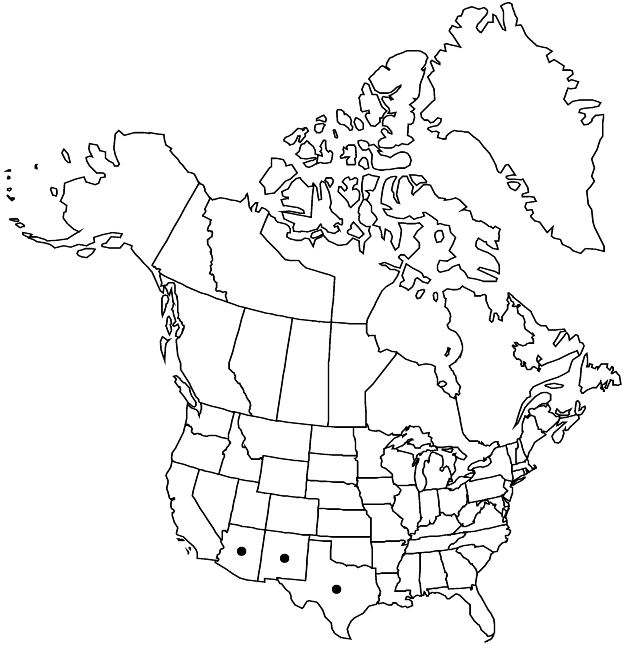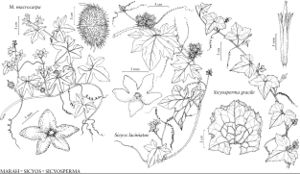Difference between revisions of "Sicyos laciniatus"
Sp. Pl. 2: 1013. 1753.
FNA>Volume Importer |
FNA>Volume Importer |
(No difference)
| |
Revision as of 22:44, 16 December 2019
Stems densely villous and stipitate-glandular, glabrescent, remaining pubescent but not glandular. Leaves: petiole (1.5–)3–6(–8) cm; blade broadly ovate-angulate to reniform-angulate or shallowly 5-lobed, sinuses 1/5–1/4 to base, 3–5(–8) × 4–11(–13) cm, terminal lobe shallowly deltate to shallowly triangular or widely ovate, acuminate to acute, basal sinus broad-curved to nearly squared, margins evenly and shallowly dentate, teeth sharply indurate-apiculate, surfaces hirsutulous-hispidulous, sometimes abaxially viscid-puberulent and sessile-glandular when very young, glandularity deciduous by maturity; proximal pair of lateral veins closely bordering edge of basal sinus. Inflorescences: staminate 3–10-flowered, peduncle plus floral axis 3–25 mm; pistillate 4–12-flowered, peduncle 2–4(–11) mm. Flowers: staminate: corolla white, 2 mm, stamens slightly exserted; pistillate: sepals not foliaceous, linear to linear-triangular, 0.2–1.5 mm, corolla 1.5–2 mm including tube, stigmas 2-lobed. Pepos ovoid, 5–6 mm, echinate, spinules retrorsely barbellate and glabrous.
Phenology: Flowering Aug–Oct.
Habitat: Stream sides, floodplains, riparian woods, cottonwood-willow, juniper, oak, pine-oak, canyons, rocky slopes, cliff faces and bases
Elevation: (1000–)1200–2400(–3000) m
Distribution

Ariz., N.Mex., Tex., Mexico (Chihuahua, Coahuila, Durango, Nuevo León, San Luis Potosí, Sinaloa, Sonora, Tamaulipas, Zacatecas).
Discussion
Selected References
None.
